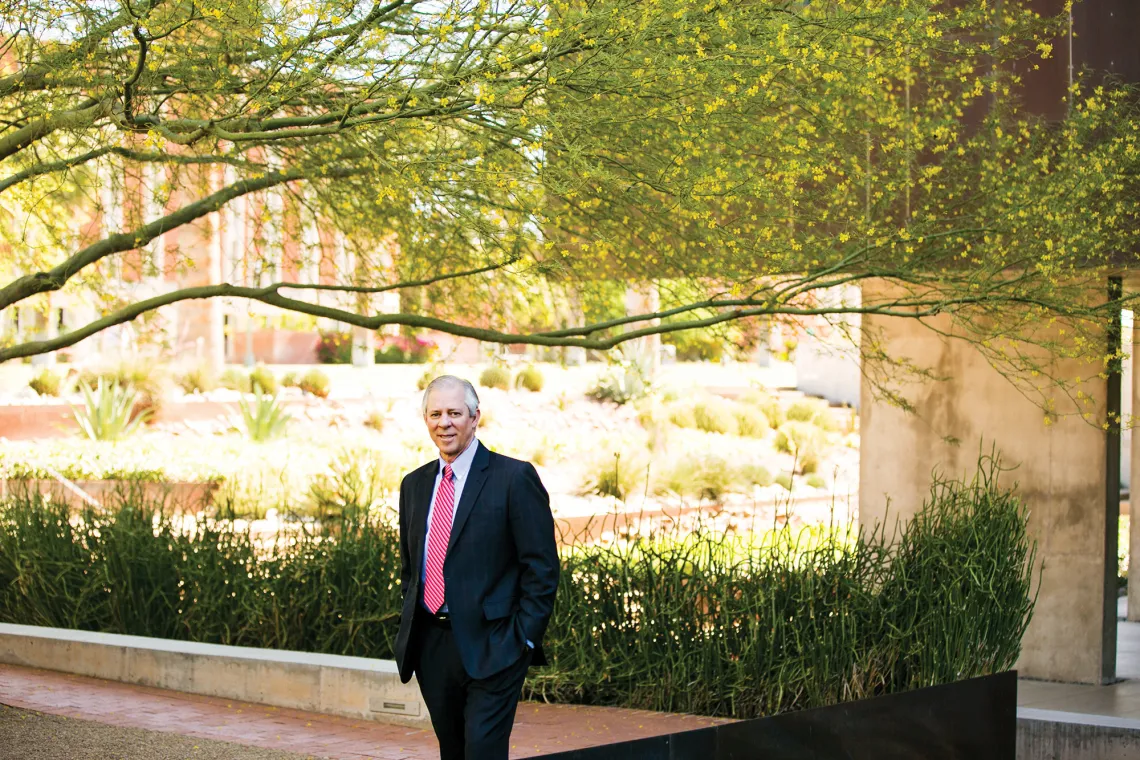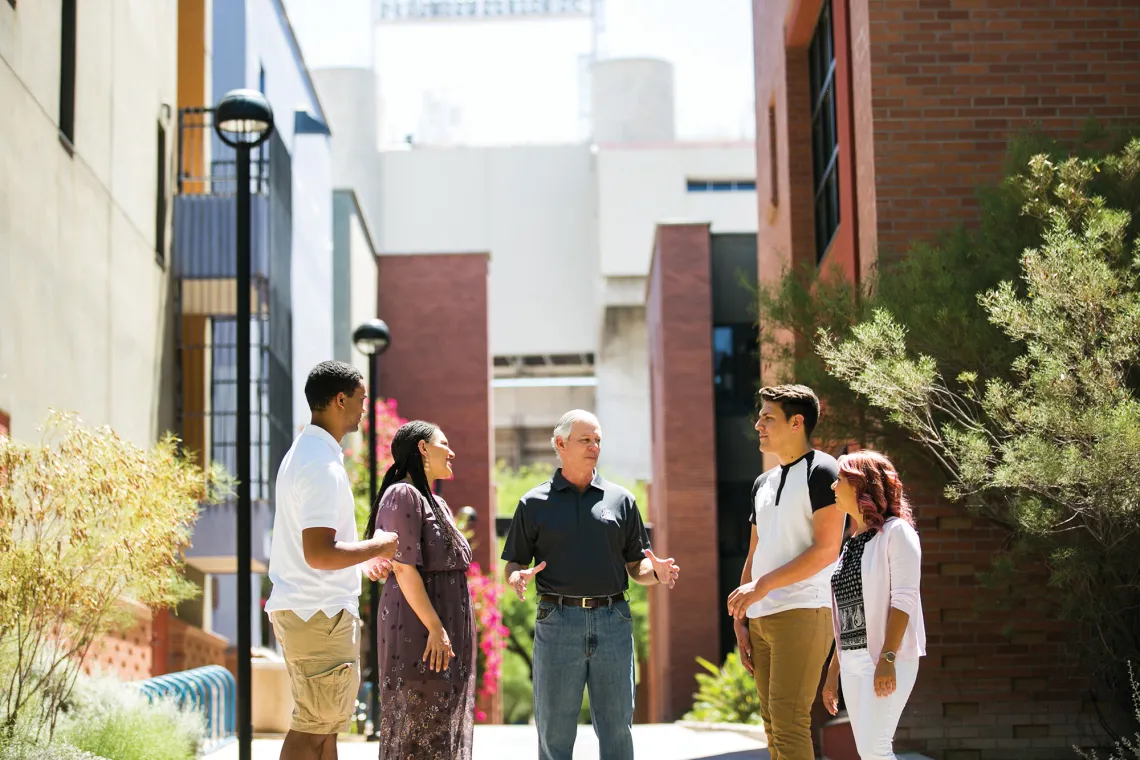A New Era of Collaboration
Q&A: Robert C. Robbins

Dr. Robert C. Robbins became the 22nd president of the University of Arizona on June 1 after serving as the president and CEO of the Texas Medical Center in Houston from 2012 to 2017. His tenure led to greater collaboration throughout TMC, including five cross-institutional research initiatives centered on innovation, genomics, regenerative medicine, health policy and clinical research.
Prior to his role at TMC, Robbins served as professor and chairman of the Department of Cardiothoracic Surgery at the Stanford University School of Medicine and founding director of the Stanford Cardiovascular Institute. He is a world-renowned cardiac surgeon and author of more than 300 peer-reviewed articles. He holds a B.S. in chemistry from Millsaps College in Mississippi and an M.D. from the University of Mississippi.
Since coming to the UA, Robbins has traveled around Arizona and the U.S. to introduce himself to the UA’s alumni and donor communities, with receptions in Tucson, Phoenix, Flagstaff and Pinetop as well as San Diego, Orange County and San Francisco. He also has visited New York City, Washington, D.C. and Jackson Hole, Wyoming. Robbins will continue to meet with UA alumni around the country throughout the first year of his presidency. He hopes to engage alumni and donors as he works to advance priorities for the UA and the Arizona Board of Regents, which include ensuring a first-class student experience, leadership in health sciences teaching and research, and enhanced marketing and branding.

Q: Why the University of Arizona?
A: The University of Arizona is an amazing place that has everything I could have hoped for — outstanding students, world-class faculty who have achieved tremendous success in research and discovery that has the UA ranked in the top 25 of public universities in research expenditures. And it is capable of creating positive change throughout the world on multiple levels. Scholars throughout the world recently ranked the University of Arizona among the top 100 public and private universities in the world (top 42 in the U.S.). I knew from the moment I was a candidate the UA was a perfect fit for me and that I would be inspired to do everything I can to grow and maximize its impact.
All universities have excellent missions — to convey existing knowledge and discover new knowledge. However, the UA takes these missions to a new level. We do not just teach students, we engage them in experiences that prepare them for the world when they graduate and for decades beyond. We do not just do research, we are at the forefront of discoveries that will change how we view the world, like the OSIRIS-REx mission, and how we live our lives, like the Precision Medicine Initiative.
After I was named president and moved to Tucson, I started making visits to campus when I could talk with students, faculty, staff and even visitors on an informal basis, and I found out that the community of people who live and work here make the UA really special. The UA’s history of collaborative research and learning is a great foundation. We have an incredible team of champions and — as I’ve said — I want to help create a championship team.
Q: What are a few of the greatest opportunities you see for the university?
A: There are so many opportunities at the University of Arizona, from agriculture to space to human health. One of the most incredible things I have seen so far at the university is the Precision Medicine Initiative cohort program, which is funded by the National Institutes of Health (NIH) and is a partnership with Banner Health and several other academic medical centers around the country. This program uses the university’s expertise in genetics and genomic medicine to better understand how we can individualize medicine. It has the potential to revolutionize how we think about and practice health care. This is just one of the incredible examples of how the UA puts knowledge into practice. Our biggest opportunities are in doing this across the university, from research to student learning.
This environment and this moment are tailor-made for the University of Arizona because we have a history of collaboration across disciplines and of translating new knowledge to address the problems and challenges we face. Part of this is the university’s land-grant history — service to Arizona, especially in agriculture, by making expertise accessible and active on behalf of people and communities. With this history, we can and should be on the leading edge of the fourth industrial revolution, which will change how we use technology and how it intersects with many other areas of our lives, from biology and health, like the precision medicine program, to how we get to work with driverless cars. Tech Launch Arizona has begun to accelerate the UA’s commercialization and technology transfer operations, which are crucial parts of that work. We have a great opportunity to use that momentum to change the university’s culture and encourage everyone to work together to anticipate and address the changes that will come over the next several decades.
For our students, learning at a university focused on these opportunities can be an avenue to leadership in the global society we are forming. We need to understand how these technological changes impact our relationships with one another, and the UA can be a thought leader in addressing that question, especially if we focus on helping students develop into well-rounded and civically engaged community members who are ready and willing to contribute to the world around them.
Q: What do you like so far about being a Wildcat?
A: This community is incredible. I have really enjoyed walking throughout campus and meeting students, faculty and staff, and I am committed to learning as much as I can about the university and the people here. My first day we held an open house in Old Main. Hundreds of people turned out and I got to meet and speak individually with many of them. Their passion for this university and the work they do here is inspiring, and I am excited to be the UA’s biggest advocate and storyteller.
I’m also excited about Arizona Athletics. I said at the open house on my first day that I’m looking forward to the football game against the University of Houston this fall. UH’s president, Renu Khator, is a friend of mine, and I’m looking forward to a Wildcat victory and to rooting on our teams throughout the year.
Q: What have been your early impressions about campus and the Tucson community?
A: This is a beautiful, vibrant campus. Each chance I get to walk along the Mall or through some of the older parts of campus, I’m struck by the architecture, the sunshine and the welcoming feel of this campus. I feel at home here in Arizona and at the UA. I am also very impressed with Tucson’s downtown. We are fortunate our main campus is located so close to the downtown area, which has great energy from the incredible investments and business developments over the past several years. I’ve had a chance to meet with many people at some of the restaurants downtown, which are outstanding. I was also very interested to learn that Tucson was the first U.S. city to be designated a World City of Gastronomy by the United Nations Educational, Scientific, and Cultural Organization (UNESCO), which is an amazing honor, and it is outstanding that the UA was part of the collaboration that led to this designation. With this amazing energy in Tucson, the UA has an opportunity to contribute to the continuing revitalization of downtown, which will have an important impact on the city and entire region. I’m looking forward to working with partners to make sure that happens.
Q: How can alumni and donors help you as you begin as president of the UA?
A: Be engaged. I am struck by how deeply and strongly our alumni feel connected to their UA experience. Alumni who love the university can volunteer their time in a variety of ways or support the university through a donation. Donations from alumni have incredible significance. In addition to the opportunity to financially support the university, every alumni donation (even a $1 donation) literally raises the stature of the university. One significant measure of university rankings in the U.S. News and World Report is the percent of alumni who donate — not the size of the donation but the percentage of alumni who make any donation at all.
I’m excited to be the UA’s uniter and a collaborator with many on campus and in our community of supporters and friends around the world. We have more than 270,000 alumni who live and work all over the world. That’s a lot of talented people who can be an important resource for our students and faculty. We can all work together to strengthen the university and its impact.
I’m also looking forward to learning about the connections alumni and donors have with the UA and why the UA is important to them. I welcome their ideas for how we can best partner for the future of the UA, and I am excited to start a conversation with our alumni community.
‘We will strengthen existing relationships and build new collaborations to take the University of Arizona to even higher levels of achievement, working to solve the 21st century’s most complex, global challenges.’ — Robert C. Robbins
